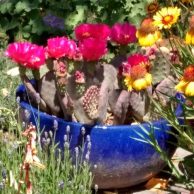 We know that not all of customers live in a house with a yard. Many of you live in apartments or condominiums or townhomes and have only a balcony or a very small patio on which to grow anything outdoors. We would love to help you make the most of your outdoor space, even if it’s tiny.
We know that not all of customers live in a house with a yard. Many of you live in apartments or condominiums or townhomes and have only a balcony or a very small patio on which to grow anything outdoors. We would love to help you make the most of your outdoor space, even if it’s tiny.
Many vegetables, ornamental annuals, and most culinary herbs can be planted in almost any kind of container as long as there’s sufficient width and depth to accommodate the roots and enough soil mass to hold sufficient water. That means that you should be sure the pot is big enough to hold the roots and potting soil. There should be enough room for potting soil so that when you water, it can be absorbed into the soil around the roots. Make sure your container has at least one drainage hole, and won’t require watering more than once a day. DO NOT fill the base of the pot with gravel, rocks, Styrofoam, or any material other than soil. This creates a perched water table and will be harmful to plant roots.
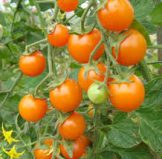
Sungold Tomato
Best Vegetables for Containers
The following types and varieties of vegetables that we offer this year can do very well grown in pots. Varieties requiring extra- large or specialty containers are listed with an (L) after the name. Read their descriptions in the PLANTS section of our website.
GREENS: Arugula, Sorrel, Kale, Mizuna, Shiso, Mustards, Lettuce (especially when heavily seeded and treated as cut-and-come-again through spring), Watercress, Spinach, Swiss Chard, Scallions, Endive
POTATOES: In large fabric grow-bags or half-barrels (plant tubers by end of April)
PEAS: Dwarf varieties (plant seeds of this cool-season veggie early in the spring, or in August for fall peapods)
CUCUMBERS: Spacemaster, Bush Champion, and Mexican Gherkin are successful in containers. Provide stakes for the relatively short vines, or allow the Mexican Gherkin to hang down from a container atop a wall.
TOMATOES:
Dwarf and micro-dwarf varieties: Jochalos, Pinocchio Orange, Tasmanian Chocolate, Vilma.
Cascading varieties: Hundreds and Thousands or Rosy Falls.
Determinate varieties: Black Sea Man, Burrell’s Special, Bush Early Girl, Glacier, Gold Nugget, Healani, Juliet, Lemon Drop, Martino’s Roma, Mountain Delight, Native Sun, Orange King, Red Robin (in shade or indoors), Stupice, Sunrise Sauce, Super Sioux, Taxi, Tidy Treats, Tumbling Tom.
Note: Larger indeterminate varieties can be grown in Earth Box self-watering planters or other large containers if support trellising is provided. Transplant by June 15 to ensure a crop from these long-season vegetables.
PEPPERS: All peppers can be grown in containers, but varieties over 16” tall should have support. Peppers appreciate a bit of shade, especially in the afternoon, to prevent sunscald. Especially well suited to containers are Shishito, Jalapeno, Adaptive Early Thai, Aurora, Mini Bell, Purple Cayenne, Fish, Lanterna Piccante (L), Cambucci (L), Bishop’s Hat (L), Gypsy Queens. Transplant by June 15 to ensure a crop from these long-season vegetables.
EGGPLANTS: Asian varieties like Orient Express, Pingtung Long Purple Comet, and shorter classic varieties like Morden Midget do very well. And all eggplants do well in containers with rich soil and consistent watering. Provide support, specially for heavy-fruited varieties. Eggplants like heat, so dark pots in a sunny location work well. Transplant by June 15 to ensure a crop from these long-season vegetables.
STRAWBERRIES: Most Strawberry varieties can grow well in containers, especially if protected from critters. If the container is large enough, like a wooden half-barrel, they should overwinter successfully. We do not recommend using ‘strawberry pots’ with multiple side ‘pockets’ because they are difficult to keep watered in our climate conditions.
CARROTS: Most carrots are not good candidates for container growing. The exceptions are varieties ‘Little Fingers’ and ‘Tonda di Parigi’ (Round of Paris). These are meant to be harvested small and are fairly quick to mature, leaving room for a late crop, like basil or kale.
VEGETABLES NOT SUITED TO CONTAINER GROWING
The following are less likely to grow well in containers: Broccoli, Cauliflower, Cabbage, Brussel Sprouts, Celery, Celery Root, Artichoke, Asparagus, full-sized Carrot, Beet, Turnip, Rutabaga, Parsnip, Squash, Melon, Watermelon, most Cucumber, Onion, Leek, Garlic, Shallot, Bean, Corn.
ANNUALS IN CONTAINERS
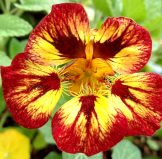
Nasturtium, ‘Orchid Flame’
Nearly all annual flowers can be grown in containers. If you want to grow it in a pot, give it a try! If you are planning to mix annuals in a pot, be sure to do a little homework to find out what each variety’s soil, fertilizer, light and water needs are, and group them accordingly. For example: In rich soil, Nasturtiums grow lots of leaves and few flowers, while Petunias bloom well.
You can crowd plants closer together in a container of Annuals, but don’t overdo it. We usually plant them 4” apart. Some annuals can grow exceptionally tall, like Lion’s Mane (Leonotis nepetifolia or L. leonurus) and could be vulnerable to breaking and spoiling the display. If you are using trailing plants, choose a pot that is tall enough to let the trailing plants trail.
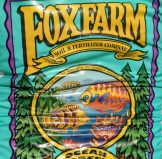
Ocean Forest Potting Soil
POTTING SOILS: We recommend Ocean Forest and Coco Loco potting soils for most container plantings. See product descriptions here. We add Harlequin’s Fertility Mix or Age Old ‘Grow’ or one of Thompson’s Organic Fertilizers to most vegetable and ornamental containers. When transplanting into the container, we use a mycorrhizal inoculant product.
A valuable product to add to you potting soil is Hydrosource. It can save you a lot of time and worry by holding more water and holding it longer, making it available to you plants throughout the day. This can be especially helpful when you are growing multiple plants together in a pot. Don’t use more than the recommended amount (too much of a good thing can be very bad!).
Annual Culinary Herbs such as basil, cilantro, parsley, dill, Mexican Oregano, Chives, and Vietnamese Coriander appreciate rich soil.
Perennial Herbs like Rosemary, Oregano, Sage, Savory and Thyme do better with Yum Yum Mix fertilizer, which offers trace minerals, phosphorus and potassium but not much nitrogen.
Succulents and Cacti are better grown in a mix that is composed of about two-thirds granular material (gravel, scoria, tufa, coarse sand) and the remainder organic material (conventional potting mix of peat moss and perlite. Our Crump’s Cactus Succulent Potting Mix does well. Do not add compost or worm castings.
YEAR-ROUND PLANTINGS IN OUTDOOR POTS
A good rule of thumb: If you are planning to grow perennials, roses, shrubs or trees in them year-round, the Brooklyn Botanic Gardens recommend that your plants should be cold-hardy to three USDA zones colder than the zone where you are gardening. This is because the roots are above the ground, exposed to much more cold than if they were planted in the earth. When looking at USDA hardiness zone ratings, the lower the number, the colder the winter temperature the plant can withstand. In the cities of Boulder and Denver, our USDA hardiness zone changed several years ago from Zone 5 to Zone 6 because our low temperatures in winter have been less cold than they used to be. So here in Zone 6, plantings in pots that remain outdoors all year should be rated as hardy to USDA zone 3, 2 or 1. Most outdoor pots or planters offer little or no insulation from cold air temperatures. If it is possible to move the container for winter against a north-facing wall and pack sealed bags of loosely-packed leaves around them, the insulation can add an extra zone or two. Against a north wall, temperatures will fluctuate less and snow, which is a very good insulator, will stay on and around the pots much longer. If there isn’t consistent snow-cover, be sure to water pots a couple of times per month.
Our personal experience: At Harlequin’s, we have successfully grown some shrubs and small trees in very large pots. A small ‘character’ Russian Hawthorn, which is hardy to Zone 2, has lived for about 10 years in a big, thick stoneware pot. We move it every winter and pack shredded leaves all around it. A ‘Walker’ Weeping Peashrub, hardy to Zone 3, lived in a 24” diameter foam pot at the nursery for about 5 years, but died from lack of winter watering. Eve used to successfully grow a few roses in wooden pots, moving them to a sheltered north wall and packing bags of leaves around them until mid-April.
There are other factors to be considered, namely your micro-climate, and the size, material and thickness of your container. If your pot is very large, say at least 24” diameter, and at least 18” deep (unlikely on a balcony!), you can plant in the center and the surrounding mass of soil will give the plant roots extra insulation. As for materials, ceramic, metal, concrete, resin and plastic conduct cold readily. Wood and double-walled plastic or resin pots do not conduct cold so they offer some insulation. Fabric pots are too thin to function as insulators.
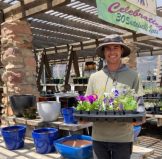 TERRACOTTA (unglazed, low-fire clay)
TERRACOTTA (unglazed, low-fire clay)
Terracotta pots are the classic flower pot. They look great. They work very well in places like England, southern Europe, the Middle East, Southern California and Mexico. But because the humidity here is usually very low and the wind is so often present, unglazed terracotta clay pots, which are fired at low temperatures and are quite porous, dry out quickly and draw moisture out of the potting soil within. So they are only suitable for desert plants. Even cacti and desert succulents will need more frequent watering if placed outdoors in a terracotta pot. Large terracotta pots are fairly heavy, are easily broken or cracked, and cannot withstand the freezing and thawing of winter weather. They will need to be brought indoors to a frost-free space for the winter.
STONEWARE (high-fired clay, unglazed or glazed)
Stoneware pots can usually be left outdoors year-round if the plantings in them are very hardy. The glazed stoneware pots we carry are considered ‘frost-resistant’. Pots with soil in them should be covered (with an overturned saucer or similar) or brought indoors for winter, and empty pots should be overturned or covered.
PLASTIC or RESIN
These cast pots have the advantage of being very light-weight, but they can differ widely in their durability. Try to assess the outside finish, whether it will chip or scratch easily. Thin plastic can crack, but Resin seems stronger. Make sure the pot has drain holes or that holes can be drilled in the bottom of the pot. We offer used large black plastic nursery pots (#7 and #10) for sale a t very reasonable prices. These are economical, perform very well, but are not ornamental or stylish. We used to have a source for wonderful, clay-toned double-walled cast resin pots The 3/8” air space between the inner and outer walls provided excellent insulation and the finishes held up for many years. Covid put an end to our supply, and we haven’t been able to find any since. Keep an eye out for them at yard sales!!
FABRIC
We are carrying a very economical fabric pot by Root Pouch. These are practically weightless, the color of the felt-like fabric is a neutral gray. They have two well-attached handles for ease of moving the pot. And under normal use, they will last for three or four years. The dimensions are 12” high and 14” diameter, making them large enough for growing a tomato, pepper or eggplant. At only $7.50 each, they are a great bargain and a very practical choice for growing plants on a balcony.
WOOD
Wooden planters are usually not as heavy as ceramic, have some insulation value and hold moisture in. They will usually fall apart within about 10 years, depending on how well they are made. Half-barrels from whiskey distilleries are heavy-duty (and heavy!) and can last longer. They are some of the best containers for planting shrubs or trees.
CONCRETE & HYPERTUFA
Concrete containers are expensive, extremely heavy and difficult to move. They conduct cold and heat. However, if they are large enough and you get help placing them, they can be very durable and have good potential for long-term plantings.
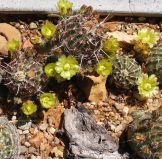
Echinocereus viridiflorus in trough garden
HyperTufa is made from a concrete mix with peatmoss, and often perlite and fiberglass added. They are thick-walled and insulating, and are durable if made well and are not as heavy as concrete. One of the best things about them is that they look a lot like stone. Hypertufa containers are usually called ‘troughs’ because they imitate ancient stone troughs from Europe. Because they are made with concrete, they offer an environment that is perfect for rockery plants that grow in limestone formations.

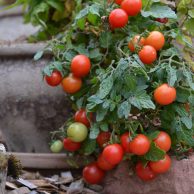

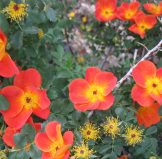
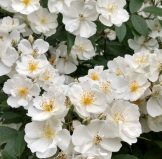
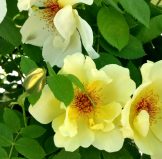
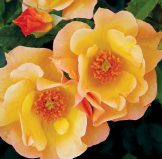
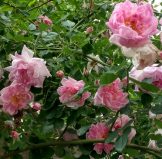
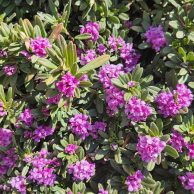
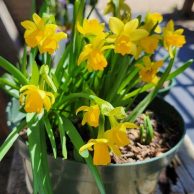 Miss planting bulbs last fall? No worries, we’ve got you covered. Choose from miniature daffodils, chionodoxa, hyacinth, tulips and more.
Miss planting bulbs last fall? No worries, we’ve got you covered. Choose from miniature daffodils, chionodoxa, hyacinth, tulips and more.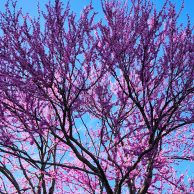 The fields and the foothills are turning green! So many trees are blooming or beginning to leaf out! There is so much energy bursting forth everywhere I look! After the lovely rain last weekend we emerged from our Sunday class to be greeted by the singing of frogs in a big puddle in the parking lot! How can they develop that fast???
The fields and the foothills are turning green! So many trees are blooming or beginning to leaf out! There is so much energy bursting forth everywhere I look! After the lovely rain last weekend we emerged from our Sunday class to be greeted by the singing of frogs in a big puddle in the parking lot! How can they develop that fast???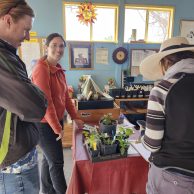
 There’s much to do in the garden in April, from finalizing your garden plan, attending to your tools, to the annual spring clean up and pruning and lawn and vegetable garden prep.
There’s much to do in the garden in April, from finalizing your garden plan, attending to your tools, to the annual spring clean up and pruning and lawn and vegetable garden prep.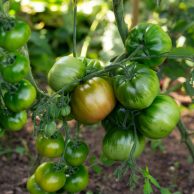
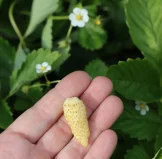
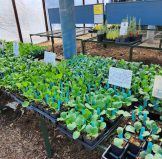 VEGETABLES
VEGETABLES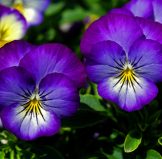
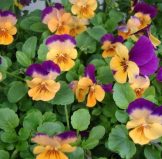
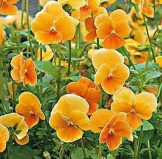
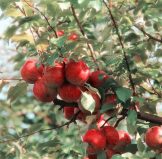 Lots of Fruit Trees: the best cherries, plums and apples for the Front Range!
Lots of Fruit Trees: the best cherries, plums and apples for the Front Range!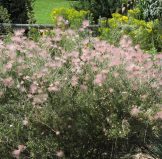
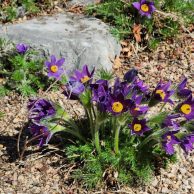
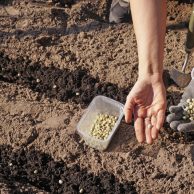 March is bringing us a characteristic tilt of the see-saw that this month always brings. Tank tops can go back in the drawer for a little while, as this week we will see night-time temperatures dipping into the mid-20s. We are expecting rain (~1.6 inches in Boulder, ~3 inches in Denver!), and heavy, wet snow, too. We’ve been here before; no need to panic. And we need the moisture!
March is bringing us a characteristic tilt of the see-saw that this month always brings. Tank tops can go back in the drawer for a little while, as this week we will see night-time temperatures dipping into the mid-20s. We are expecting rain (~1.6 inches in Boulder, ~3 inches in Denver!), and heavy, wet snow, too. We’ve been here before; no need to panic. And we need the moisture!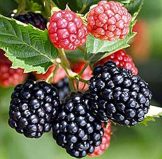 BLACKBERRY
BLACKBERRY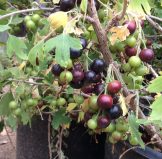 CURRANT
CURRANT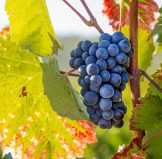 GRAPE
GRAPE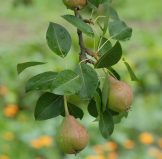 PEAR
PEAR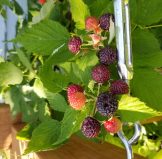 RASPBERRY
RASPBERRY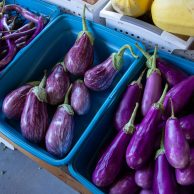

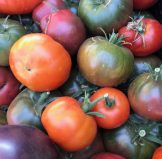 HARLEQUIN’S GARDENS 2024 TOMATO STARTS
HARLEQUIN’S GARDENS 2024 TOMATO STARTS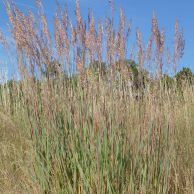
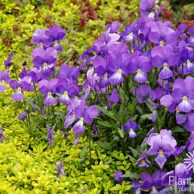
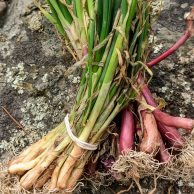
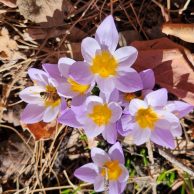
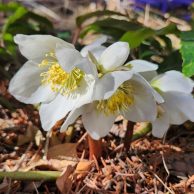
 At Harlequin’s Gardens, we’ve been reusing and recycling black plastic nursery pots since day one. It is very important to us that we minimize our plastic waste. We have always encouraged our customers to bring back to us the nursery pots that came with the plants you purchased from us, and you have responded with enthusiasm, which we appreciate!
At Harlequin’s Gardens, we’ve been reusing and recycling black plastic nursery pots since day one. It is very important to us that we minimize our plastic waste. We have always encouraged our customers to bring back to us the nursery pots that came with the plants you purchased from us, and you have responded with enthusiasm, which we appreciate!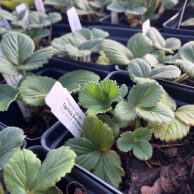


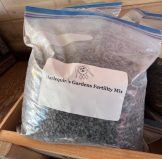
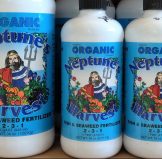 Neptune’s Harvest Organic Fertilizers
Neptune’s Harvest Organic Fertilizers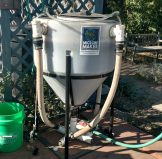 Compost Tea
Compost Tea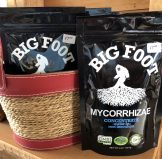 Big Foot Mycorrhizae
Big Foot Mycorrhizae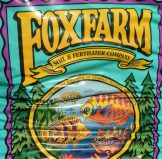 Fort Vee
Fort Vee Expanded Shale
Expanded Shale
 So even though there is nothing you can do at the moment, very soon, before it’s warm enough to plant, you can start making your bed sexy. Sexy soil sprouts seeds, grows roots and leaves, builds strength, makes flowers and fruit, and defends against pests.
So even though there is nothing you can do at the moment, very soon, before it’s warm enough to plant, you can start making your bed sexy. Sexy soil sprouts seeds, grows roots and leaves, builds strength, makes flowers and fruit, and defends against pests. Let the biology do a lot of the work. It’s not hard to add more later; it’s very hard to correct too much. Keep the soil covered with mulch or living plants. Even native plants appreciate some compost to hold moisture and provide a light feeding when they are young. One more thing: avoid poisonous pesticides, fungicides and herbicides, like the plague. They kill or undermine the health of your allies—the soil life. Toxic pesticides are the opposite of sexy; they are like inviting the Grim Reaper into the bedroom. There are effective, non-toxic alternatives.
Let the biology do a lot of the work. It’s not hard to add more later; it’s very hard to correct too much. Keep the soil covered with mulch or living plants. Even native plants appreciate some compost to hold moisture and provide a light feeding when they are young. One more thing: avoid poisonous pesticides, fungicides and herbicides, like the plague. They kill or undermine the health of your allies—the soil life. Toxic pesticides are the opposite of sexy; they are like inviting the Grim Reaper into the bedroom. There are effective, non-toxic alternatives.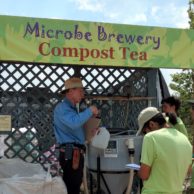 What about no-till? Not turning the soil makes sense once you’ve got the soil life in a good environment. Then you don’t want to disturb the symbiotic networks. Then you can feed from the surface; good tilth and worms will take the food down.
What about no-till? Not turning the soil makes sense once you’ve got the soil life in a good environment. Then you don’t want to disturb the symbiotic networks. Then you can feed from the surface; good tilth and worms will take the food down.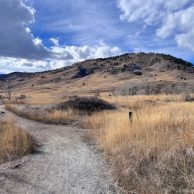
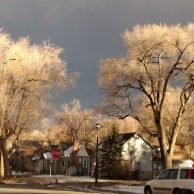
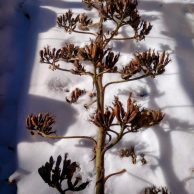

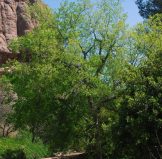
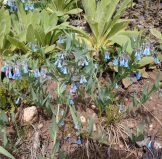
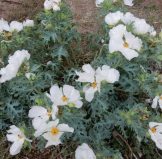
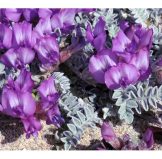
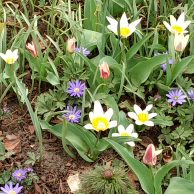
 Well, that was a false alarm!
Well, that was a false alarm!


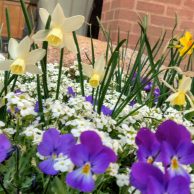
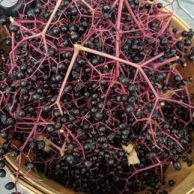

 from Mitten Lowe at
from Mitten Lowe at 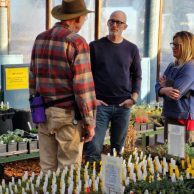
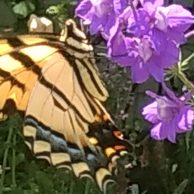
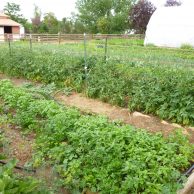 Every 5 years or so Congress has the opportunity to transform our food system by revising a piece of legislation known as the Farm Bill, which covers everything from supporting farmers to ensuring food security for all. Politicians and local and national advocacy organizations are working to determine how nearly a billion dollars a year will be spent. You can help!
Every 5 years or so Congress has the opportunity to transform our food system by revising a piece of legislation known as the Farm Bill, which covers everything from supporting farmers to ensuring food security for all. Politicians and local and national advocacy organizations are working to determine how nearly a billion dollars a year will be spent. You can help! 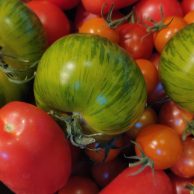 A Few New & ‘New Again’ TOMATOES:
A Few New & ‘New Again’ TOMATOES: 
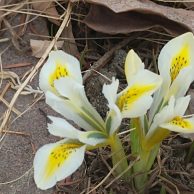
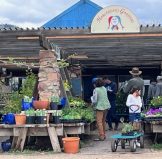 Dear Friends and Fellow Gardeners,
Dear Friends and Fellow Gardeners,